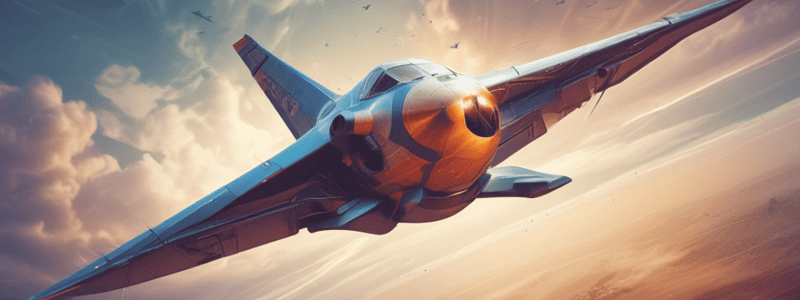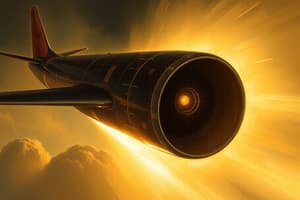Podcast
Questions and Answers
What is the primary reason an aircraft requires continuous thrust to maintain flight?
What is the primary reason an aircraft requires continuous thrust to maintain flight?
- To propel the aircraft forward
- To overcome aerodynamic drag (correct)
- To counteract the inertia of the aircraft's mass
- To generate lift
What determines the force required to achieve a certain acceleration in an aircraft?
What determines the force required to achieve a certain acceleration in an aircraft?
- Thrust generated by the engines
- Acceleration of the aircraft
- Aerodynamic drag
- Mass of the aircraft (correct)
What is the result of shutting down an aircraft's engines during flight?
What is the result of shutting down an aircraft's engines during flight?
- The aircraft will suddenly lift off the ground
- Drag and gravity will eventually bring the aircraft to a stop (correct)
- The aircraft will maintain its current speed
- The aircraft will continue to accelerate
What is the relationship between force, mass, and acceleration described by the second law of motion?
What is the relationship between force, mass, and acceleration described by the second law of motion?
What is the primary application of Newton's third law of motion in aircraft propulsion?
What is the primary application of Newton's third law of motion in aircraft propulsion?
What is the result of the reaction force generated by an aircraft's wings pushing air downwards?
What is the result of the reaction force generated by an aircraft's wings pushing air downwards?
What is the critical aspect of understanding Newton's laws of motion for pilots and aeronautical engineers?
What is the critical aspect of understanding Newton's laws of motion for pilots and aeronautical engineers?
What is the purpose of an aircraft's engines during takeoff?
What is the purpose of an aircraft's engines during takeoff?
What is the effect of a heavier aircraft on its acceleration?
What is the effect of a heavier aircraft on its acceleration?
What is the relationship between an aircraft's mass and its acceleration?
What is the relationship between an aircraft's mass and its acceleration?
According to Newton's second law of motion, an object's acceleration is directly proportional to its mass.
According to Newton's second law of motion, an object's acceleration is directly proportional to its mass.
A lighter aircraft will always require more thrust to achieve the same acceleration as a heavier one.
A lighter aircraft will always require more thrust to achieve the same acceleration as a heavier one.
The action-reaction principle is only applicable to jet engines and not to propellers.
The action-reaction principle is only applicable to jet engines and not to propellers.
An aircraft's lift is solely generated by its engines.
An aircraft's lift is solely generated by its engines.
An aircraft's acceleration is independent of its mass.
An aircraft's acceleration is independent of its mass.
The second law of motion only applies to aircraft in flight and not on the ground.
The second law of motion only applies to aircraft in flight and not on the ground.
Drag and gravity are the only forces that act on an aircraft in flight.
Drag and gravity are the only forces that act on an aircraft in flight.
The third law of motion explains how an aircraft generates lift during flight.
The third law of motion explains how an aircraft generates lift during flight.
An aircraft's engines do not generate a reaction force that contributes to its propulsion.
An aircraft's engines do not generate a reaction force that contributes to its propulsion.
Understanding Newton's laws of motion is only crucial for aeronautical engineers and not for pilots.
Understanding Newton's laws of motion is only crucial for aeronautical engineers and not for pilots.
How does the principle of continuous thrust relate to the concept of drag in aircraft flight?
How does the principle of continuous thrust relate to the concept of drag in aircraft flight?
What is the significance of the second law of motion in determining an aircraft's ability to change its speed or direction?
What is the significance of the second law of motion in determining an aircraft's ability to change its speed or direction?
How does the action-reaction principle apply to the lift generated by an aircraft's wings?
How does the action-reaction principle apply to the lift generated by an aircraft's wings?
What is the relationship between an aircraft's mass and its ability to accelerate?
What is the relationship between an aircraft's mass and its ability to accelerate?
How does the shut down of an aircraft's engines affect its motion?
How does the shut down of an aircraft's engines affect its motion?
What is the role of thrust in overcoming the inertia of an aircraft's mass?
What is the role of thrust in overcoming the inertia of an aircraft's mass?
How does the third law of motion apply to the propulsion of aircraft?
How does the third law of motion apply to the propulsion of aircraft?
What is the significance of understanding the relationship between force, mass, and acceleration in aircraft design?
What is the significance of understanding the relationship between force, mass, and acceleration in aircraft design?
How does the second law of motion impact the design of aircraft takeoff and climbing maneuvers?
How does the second law of motion impact the design of aircraft takeoff and climbing maneuvers?
What is the role of Newton's laws of motion in understanding aircraft operation and maneuverability?
What is the role of Newton's laws of motion in understanding aircraft operation and maneuverability?
Study Notes
Fundamentals of Flight: Newton's Laws of Motion
- Newton's First Law of Motion (Law of Inertia): An object at rest tends to stay at rest, and an object in motion tends to stay in motion, with the same direction and speed, unless acted upon by an unbalanced force.
- In flight, an aircraft maintains altitude and speed because the forces of thrust and drag, lift and gravity, are in balance.
- Unbalanced forces cause acceleration or deceleration, such as during climb or turn.
Newton's Second Law of Motion (Law of Acceleration)
- F = ma: Force equals mass times acceleration, describing the relationship between force, mass, and acceleration.
- The law helps understand the relationship between the force applied to an aircraft, the mass of that aircraft, and the resulting acceleration.
- During takeoff, thrust must overcome drag and the aircraft's weight to achieve lift-off; acceleration is critical.
- During landing, the pilot reduces thrust and employs flaps and other control surfaces to achieve a graceful descent.
Real-World Scenarios
- Turbulence: Unbalanced forces cause the aircraft to shake, and the pilots must adjust to maintain control and stability.
- Pilot maneuvers: Pilots actively juggle force vectors to maintain control and stability during banks, rolls, and other maneuvers.
Newton's Third Law of Motion (Law of Action and Reaction)
- Every action has an equal and opposite reaction: This law governs the forces that shape flight, particularly in aircraft propulsion.
- Jet engines: Exhaust gas is expelled rearward, and the equal and opposite reaction thrusts the aircraft forward.
- Propellers: They create low pressure ahead and high pressure behind, generating a forward-thrusting reaction that glides the aircraft through the atmosphere.
Importance of Newton's Laws in Flight
- Understanding and respecting these laws: Crucial for pilots and aeronautical engineers, as they impact every aspect of aircraft operation from design to maneuvering in flight.
- Pilot instincts: Awareness of these forces is essential for pilots to anticipate and respond to the aircraft's behavior, navigate the skies, and maintain control and stability.
Fundamentals of Flight: Newton's Laws of Motion
- Newton's First Law of Motion (Law of Inertia): An object at rest tends to stay at rest, and an object in motion tends to stay in motion, with the same direction and speed, unless acted upon by an unbalanced force.
- In flight, an aircraft maintains altitude and speed because the forces of thrust and drag, lift and gravity, are in balance.
- Unbalanced forces cause acceleration or deceleration, such as during climb or turn.
Newton's Second Law of Motion (Law of Acceleration)
- F = ma: Force equals mass times acceleration, describing the relationship between force, mass, and acceleration.
- The law helps understand the relationship between the force applied to an aircraft, the mass of that aircraft, and the resulting acceleration.
- During takeoff, thrust must overcome drag and the aircraft's weight to achieve lift-off; acceleration is critical.
- During landing, the pilot reduces thrust and employs flaps and other control surfaces to achieve a graceful descent.
Real-World Scenarios
- Turbulence: Unbalanced forces cause the aircraft to shake, and the pilots must adjust to maintain control and stability.
- Pilot maneuvers: Pilots actively juggle force vectors to maintain control and stability during banks, rolls, and other maneuvers.
Newton's Third Law of Motion (Law of Action and Reaction)
- Every action has an equal and opposite reaction: This law governs the forces that shape flight, particularly in aircraft propulsion.
- Jet engines: Exhaust gas is expelled rearward, and the equal and opposite reaction thrusts the aircraft forward.
- Propellers: They create low pressure ahead and high pressure behind, generating a forward-thrusting reaction that glides the aircraft through the atmosphere.
Importance of Newton's Laws in Flight
- Understanding and respecting these laws: Crucial for pilots and aeronautical engineers, as they impact every aspect of aircraft operation from design to maneuvering in flight.
- Pilot instincts: Awareness of these forces is essential for pilots to anticipate and respond to the aircraft's behavior, navigate the skies, and maintain control and stability.
Fundamentals of Flight: Newton's Laws of Motion
- Newton's First Law of Motion (Law of Inertia): An object at rest tends to stay at rest, and an object in motion tends to stay in motion, with the same direction and speed, unless acted upon by an unbalanced force.
- In flight, an aircraft maintains altitude and speed because the forces of thrust and drag, lift and gravity, are in balance.
- Unbalanced forces cause acceleration or deceleration, such as during climb or turn.
Newton's Second Law of Motion (Law of Acceleration)
- F = ma: Force equals mass times acceleration, describing the relationship between force, mass, and acceleration.
- The law helps understand the relationship between the force applied to an aircraft, the mass of that aircraft, and the resulting acceleration.
- During takeoff, thrust must overcome drag and the aircraft's weight to achieve lift-off; acceleration is critical.
- During landing, the pilot reduces thrust and employs flaps and other control surfaces to achieve a graceful descent.
Real-World Scenarios
- Turbulence: Unbalanced forces cause the aircraft to shake, and the pilots must adjust to maintain control and stability.
- Pilot maneuvers: Pilots actively juggle force vectors to maintain control and stability during banks, rolls, and other maneuvers.
Newton's Third Law of Motion (Law of Action and Reaction)
- Every action has an equal and opposite reaction: This law governs the forces that shape flight, particularly in aircraft propulsion.
- Jet engines: Exhaust gas is expelled rearward, and the equal and opposite reaction thrusts the aircraft forward.
- Propellers: They create low pressure ahead and high pressure behind, generating a forward-thrusting reaction that glides the aircraft through the atmosphere.
Importance of Newton's Laws in Flight
- Understanding and respecting these laws: Crucial for pilots and aeronautical engineers, as they impact every aspect of aircraft operation from design to maneuvering in flight.
- Pilot instincts: Awareness of these forces is essential for pilots to anticipate and respond to the aircraft's behavior, navigate the skies, and maintain control and stability.
Studying That Suits You
Use AI to generate personalized quizzes and flashcards to suit your learning preferences.
Related Documents
Description
Explore the fundamental principles of aerodynamics, focusing on Newton's first and second laws of motion and their applications in aircraft design and performance.




